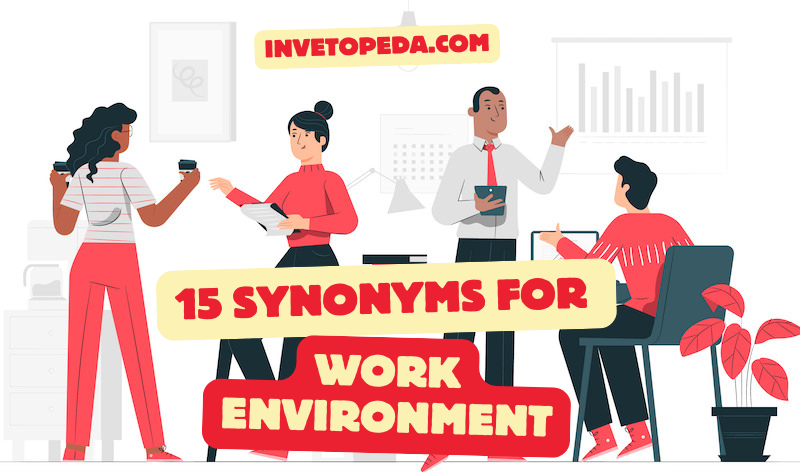The word work environment has a significant role in the professional world. It is the physical space as well as psychologically-based–in which we spend an extensive portion of our working time. Learning different ways of describing the workplace is not just a way to improve the communication abilities of your employees, but it can also assist you in describing your work environment more clearly through the form of writing or conversation.
In this comprehensive guide, we’ll look at 15 terms and phrases for work environments and the workplace, each supported by an example and context to help you broaden your vocabulary and be able to communicate efficiently.
1. Workplace
“Workplace” is the most commonly used word for the workplace. It refers primarily to the place where workers perform their work. It could be an office for corporate purposes, a manufacturing floor, a retail store, or even a construction site.
It is a broad term that can be easily understood, which makes it ideal to use in everyday life. Saying, for example, “Our workplace has adopted new health protocols”, effectively describes the physical area.
2. Work Setting
The concept of “work setting” adds an additional layer of significance beyond the place of work. It refers to the ambience as well as the layout and the interpersonal dynamics within the work environment. In the example above, “collaborative workplace” refers to a “collaborative work setting”, implying the environment in which collaboration is encouraged.
The term is frequently employed in reports for professionals and discussions in academic circles about workplace conditions.
3. Office Atmosphere
The emphasis is placed on the social and emotional work environment of work. The atmosphere of the workplace can impact people’s mood and enthusiasm, and productivity. Offices provide a relaxing and welcoming environment that is clear and transparent in sharing information and respecting each other, and an inviting warmth .This is a great phrase to use when discussing workplace culture, corporate gatherings, or in written articles.
4. Professional Environment
“Professional environment” emphasizes the professional, formal nature of work. It is a place that is one where ethics, professionalism and a structured manner of conduct are accepted. The term can be used for workplaces like law firms, hospitals and financial institutions in which the importance of formal behavior is high. In this case, for example, “She thrives in a professional environment that values punctuality and precision.”
5. Corporate Culture
Corporate culture is the common values, beliefs and standards that determine the manner in which employees interact and act in an organization. In contrast to the physical environment the corporate culture is based on what is the “personality” of the company. A positive corporate culture is able to encourage innovation, loyalty and satisfaction with work. Expressions such as “The corporate culture here promotes creativity” emphasize this non-tangible essential aspect of the workplace.
6. Working Conditions
This term is used to describe the physical and occasionally psychological aspects that affect how employees complete their duties. The working conditions encompass things like light and noise levels as well as ergonomics and security measures. In one instance, “The factory has improved its working conditions by upgrading ventilation systems.” This phrase is commonly employed in discussions about labour and the context of employee rights.
7. Business Environment
While it is more extensive than the physical work environment, the “business environment” encompasses both internal and external factors that affect the operations of a business. It includes trends in the market as well as competition, the economy and corporate policies. The phrase “Our business environment is competitive” suggests a difficult environment that affects the work environment of employees through indirect means.
8. Employment Setting
Employer setting is a formal word that describes the legal and social elements of an employee’s workplace of work. It could refer to whether a person has a full-time job, a remote position or a part-time job in a specific setting. As an example “Her employment setting involves remote work with flexible hours.”
9. Organizational Climate
It is an integral aspect of corporate culture. However, it is focused on the perceptions of employees as well as their attitude towards their work. The way employees perceive management, communication and appreciation within the workplace. An environment that is positive for the employees increases morale and involvement. Like, “The organizational climate at the company is supportive and inclusive.”
10. Work Atmosphere
It is a term that resembles workplace atmosphere, but it can be utilized in all workplaces and not only in workplaces. It is a way to describe the energy, mood as well as the interactions among workers. Like, “The work atmosphere in the marketing department is energetic and creative” indicates the lively and stimulating atmosphere.
11. Job Site
“Job site” is a common term used to describe sectors like mining, construction or fieldwork. It refers to the precise site where the specific jobs are performed. Like, for instance, “Safety protocols are critical on the job site.” The term “safety protocols” is more conceptual than the term “work environment” and is extremely specific to the location.
12. Work Locale
Work location is the geographic or physical space in which workers work. It could refer to a city, neighbourhood, or even a specific structure. It could be, for instance, “The work locale in downtown offers great access to public transportation.” It’s an informal or poetic way of discussing the place where work takes place.
13. Corporate Setting
The term is perfect for the description of work environments inside large corporations or formal organizations. This implies a place that is defined by rules, hierarchies and procedures. In this case, “She adapted quickly to the corporate setting after moving from a startup environment.”
14. Industrial Environment
The industrial environment specifically refers to areas of work that are associated with production, manufacturing, or heavy equipment. It emphasizes factors like security, noise, and operating procedures that are unique to these areas. In particular, “The industrial environment requires strict safety gear and protocols.”
15. Remote Workspace
Due to the increasing popularity of remote working models and telecommuting and telecommuting, the “remote workspace” has gained increasing importance. It refers to workplaces which aren’t typical workplaces like homes, cafes, offices or co-working zones. As an example, “The company supports employees by providing resources for a comfortable remote workspace.”
Why Knowing Different Terms for Work Environment Matters
The use of a broad language to define your workplace will enable you to be more precise and efficient in your communication. In producing reports, preparing presentations or talking about your work, picking the correct word is helpful in conveying the nuances of the physical environment, areas, and the culture and also the working conditions and atmosphere in the workplace.
Utilizing different phrases can help make sure that your message or writing is engaging and avoids repetition. In this case, switching among “workplace,” “office atmosphere,” and “corporate culture” helps highlight different aspects of workplace culture.
How to Choose the Right Term for Your Context
There are many synonyms for workplace surroundings that can be interchangeable. Be aware of these elements when deciding on the most appropriate phrase
- Physical Locality: Use terms like workplace, job site or workplace.
- Social or emotional tone: Choose an office atmosphere and work environment or an organizational atmosphere.
- Graduation Level: Professional environment, workplace or corporate environment is formal.
- Industries-specific: Industrial environment or work site that is suited to specific sectors.
- Remote Work: Utilize remote workspaces for discussions on the possibility of telecommuting.
- Cultural aspects: The corporate culture and the organizational culture are focused on common beliefs and values.
Conclusion
Utilizing a variety of terms in your work environment could significantly improve communication, whether in the professional world of writing and presentations or just casual chats. Each one of these terms illuminates a distinct aspect of workplace life that ranges from physical surroundings to cultural aspects. When you integrate these options in a thoughtful manner and effectively, you’ll be able to define your workplace in a more precise and effective manner.
When you next talk about work or your profession, try mixing up your vocabulary using these terms. It will make you appear more knowledgeable and lucid, which will make your talks or your writing more engaging and efficient. Read More!

